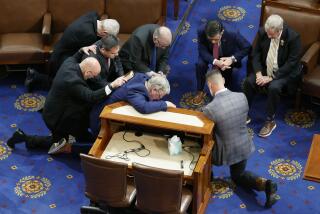Growth of TV Ministries Translates Into Clout
WASHINGTON â The annual convention of the National Religious Broadcasters brings together most leaders of conservative Protestantism, in no small part because their radio and television ministries helped to establish their leadership.
For instance, Atlanta Pastor Charles Stanley, current president of the 14-million-member Southern Baptist Convention, also has a television program and serves on the religious broadcastersâ board.
But the meeting appears to have the capacity to attract political attention because of the numbers reached through a variety of means--church conferences, books, magazines and broadcasting.
Evangelical and fundamentalist Protestants are outnumbered by liberal-to-moderate âmainlineâ Protestants by 34% to 30% of the population, according to sociologist Wade Clark Roof of the University of Massachusetts. But his study also indicates that the ratios could soon reverse because of the aging, declining membership of the mainline churches and the growth of the conservative churches.
Reaganâs strong appeal to conservative morality and religion last year apparently paid off in votes. The Los Angeles Times Poll showed last November that âborn-againâ white voters gave Reagan 79% of its vote over Democratic presidential candidate Walter Mondale, compared to 59% for the overall vote for Reagan. Reagan won about 15% less of the white âborn-againâ vote in 1980.
Just how many people religious broadcasts reach is a matter of dispute.
A major report on the impact of religious television programs released nearly a year ago indicated that the audience was much smaller than previously thought--13.3 million regular viewers, or about 6% of the potential audience. The Gallup portion of the study, however, said 18% had watched a religious television show in the week preceding the questioning.
At this weekâs National Religious Broadcasters Convention, sociologist Jeffrey K. Hadden, president of the liberal-oriented Society for the Scientific Study of Religion, praised the Gallup research but said the rest of the study âsuffered from serious methodological deficienciesâ and a biased research agenda.
Meanwhile, the number of all-religious stations has grown to 1,043 on radio and 92 on television. And 373 religious organizations produce regular TV programs for those stations and other outlets, according to the National Religious Broadcasters, based in Morristown, N.J.
More to Read
Sign up for Essential California
The most important California stories and recommendations in your inbox every morning.
You may occasionally receive promotional content from the Los Angeles Times.










